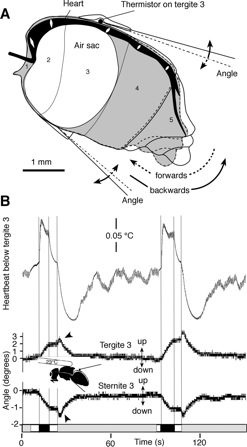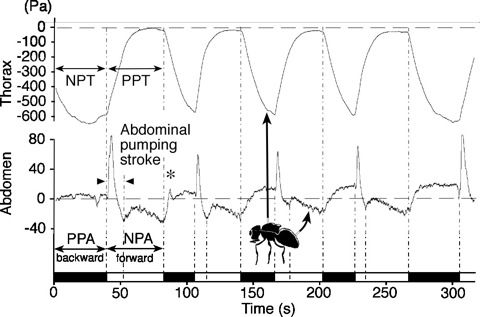Wasserthal, L.T. (2012): Influence of periodic heartbeat reversal and abdominal movements on hemocoelic and tracheal pressure in resting blowflies Calliphora vicina. J. Exp. Biol. 215, 362-373.
In Calliphoridae and Drosophilidae, the dorsal vessel (heart and aorta with associated venous channels) is the only connection between the thorax and the abdomen. Hemolymph oscillates between the compartments by periodic heartbeat reversal, but both the mechanism and its influence on hemocoelic and tracheal pressure have remained unclear. The pumping direction of the heart regularly reverses, with a higher pulse rate during backward compared with forward pumping. A sequence of forward and backward pulse periods lasts approximately 34s. Pulse rate, direction, velocity and the duration of heartbeat periods were determined by thermistor and electrophysiological measurements. For the first time, heartbeat-induced pressure changes were measured in the hemocoel and in the tracheal system of the thorax and the abdomen. The tracheal pressure changed from sub-atmospheric during backward heartbeat to supra-atmospheric during forward heartbeat in the thorax and inversely in the abdomen. The heartbeat reversals were coordinated with slow abdominal movements with a pumping stroke at the beginning of the forward pulse period. The pressure effect of the pumping stroke was visible only in the abdomen. Periodic hemolymph shift and abdominal movements resulted in pressure changes in the hemocoel and tracheal system alternating in the thorax and abdomen, suggesting an effect on respiratory gas exchange.

Fig. 9. (A) Changing contours of the abdomen during a heartbeat sequence, based on video frames (supplementary Movie 1). The slow downwards bending of the abdominal tip is combined with a reduction in the diameter of the abdominal segments. The corresponding reduction or increase in volume coincides with forward (stippled lines) and backward beating, respectively, as recorded in B). (B) Coordination of tergo-abdominal and sterno-abdominal movements with heartbeat periodicity. Grey bar: forward, black bar: backward heartbeat, white: pause, arrowheads: pumping stroke.
Fig. 10. Simultaneous recordings of hemolymph pressure in mesothorax and in abdominal segment 4. In the thorax, the pressure reflects the periodic inflow and outflow of hemolymph according to heartbeat reversal. Here, the backward pulses are measured as negative pulses (NPT). In the abdomen, they are measured as positive pulses (PPA). During backward pulse periods, the abdominal pressure increases, while during forward pulse periods it decreases. However, at the beginning of the forward pulse periods, a positive pressure peak results from the abdominal pumping stroke (indicated between arrowheads).

